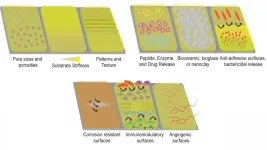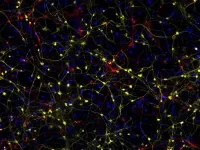(Press-News.org) WASHINGTON, April 27, 2021 -- Traffic accidents, tumor resections, and congenital diseases can cause significant trauma, which can lead to large bone deformations and/or bone loss. Although bone has some capacity to regenerate, large bone defects cannot be healed without major medical procedures.
In these situations, metallic implants are widely used, but the bioinertness of such implants poses a major challenge in bone tissue engineering. Bioinert metal implants lack bone integration, loosen over time, and may lead to adverse reactions around the area in which they are implanted.
In Biointerphases, by AIP Publishing, researchers from Middle East Technical University in Turkey showcase a variety of approaches that are alternatives to metallic implants and use natural polymer coatings to improve bone-implant integration, also known as osseointegration.
"We utilized a soft structure, which is very similar to human tissues, and placed this structure between human or animal bone and a metal surface," said author Zafer Evis. "This serves as an interphase increasing bone tendency to attach on implants and prevent loosening or bacterial invasion."
Establishing a strong and robust chemical interaction between a metal and a completely organic and natural polymer is a significant advancement in the field of bone tissue engineering. It opens a new era of applications with a broader range of modalities that can be applied in almost all hard tissue defects and traumas.
The research showcases several important findings. First, natural polymer coatings significantly improved metal electrochemical corrosion properties, and metals tend to resist corrosion after polymer coating. Second, polysaccharides and proteins can be successfully grafted onto metal surfaces without losing their biological nature.
"One of the surprises is that the coatings can be modified in unlimited ways," said Evis. "They can be composited, reconfigured, and tailored to allow or disallow certain biological activities, such as allowing cell attachment while disallowing bacterial attachment."
Coatings may also be designed to possess multifunctionality, which is the goal in tissue engineering applications.
The researchers plan to improve biological functionality of natural polymer coatings on titanium implants. Even though natural polymers can be successfully coated on metal implants, the robustness, yield, and mechanical stability of polymers on metal are still very problematic.
They will try to surpass the need for complex devices and method to improve the stability of polymer-metal interactions and eventually achieve long-term interphase durability. The methods discussed could be used in tandem with other implant surface modification methods to further enhance bioactivity of the metallic implants.
INFORMATION:
The article "Multifunctional natural polymer-based metallic implant surface modifications" is authored by Ahmet Engin Pazarceviren, Ay?en Tezcaner, and Zafer Evis. The article will appear in Biointerphases on April 27, 2021 (DOI: 10.1116/6.0000876). After that date, it can be accessed at https://aip.scitation.org/doi/10.1116/6.0000876.
ABOUT THE JOURNAL
Biointerphases, an AVS journal published by AIP Publishing, emphasizes quantitative characterization of biomaterials and biological interfaces. As an interdisciplinary journal, a strong foundation of chemistry, physics, biology, engineering, theory, and/or modelling is incorporated into originated articles, reviews, and opinionated essays. See https://avs.scitation.org/journal/bip.
ABOUT AVS
AVS is an interdisciplinary, professional society with some 4,500 members worldwide. Founded in 1953, AVS hosts local and international meetings, publishes four journals, serves members through awards, training and career services programs and supports networking among academic, industrial, government, and consulting professionals. Its members come from across the fields of chemistry, physics, biology, mathematics, engineering and business and share a common interest in basic science, technology development and commercialization related to materials, interfaces, and processing.
LA JOLLA--(April 27, 2021) Despite the prevalence of Alzheimer's, there are still no treatments, in part because it has been challenging to study how the disease develops. Now, scientists at the Salk Institute have uncovered new insights into what goes awry during Alzheimer's by growing neurons that resemble--more accurately than ever before--brain cells in older patients. And like patients themselves, the afflicted neurons appear to lose their cellular identity.
The findings, published April 27, 2021, in the journal Cell Stem Cell, showed that these brain cells are characterized by markers of stress as well as changes in which the cells become less specialized. ...
The research was conducted at the Department of Food Science at the University of Copenhagen (UCPH FOOD) with professor emeritus Lars Munck as coordinator and builds on earlier work since 1963 at Svaloef Plant Breeding Institute and the Carlsberg Laboratory.
A complete picture of the organism
The research shows how, with the help of a fast, non-destructive and green analysis method, near-infrared spectroscopy (NIRS), we can obtain a global overview that mirrors how the entire chemical composition of nutrients in a barley grain is changed, for example, by a mutation in a single gene. This is in contrast to current ...
Muscle weakness in patients with Becker disease is caused by unusual electrical activity in muscle fibres termed 'plateau potentials' that make them temporarily inactive, says a study published today in eLife.
An understanding of these mechanisms and the ion channels involved may help the search for more effective therapies for weakness in Becker disease and other muscle diseases, and help understand how electrical activity is regulated in muscles.
Recessive myotonia congenita, also known as Becker disease, is a heritable skeletal muscle disease caused by mutated chloride ...
New interfacial superconductor has novel properties that raise new fundamental questions and might be useful for quantum information processing or quantum sensing.
Interfaces in solids form the basis for much of modern technology. For example, transistors found in all our electronic devices work by controlling the electrons at interfaces of semiconductors. More broadly, the interface between any two materials can have unique properties that are dramatically different from those found within either material separately, setting the stage for new discoveries.
Like semiconductors, superconducting materials have many important implications for technology, from magnets for MRIs to speeding up electrical connections or perhaps making possible quantum technology. The ...
WASHINGTON, April 27, 2021 -- If a base station in a local area network tries to use a directional beam to transmit a signal to a user trying to connect to the network -- instead of using a wide area network broadcast, as base stations commonly do -- how does it know which direction to send the beam?
Researchers from Rice University and Brown University developed a link discovery method in 2020 using terahertz radiation, with high-frequency waves above 100 gigahertz. For this work, they deferred the question of what would happen if a wall or other reflector nearby creates a non-line-of-sight (NLOS) path from the base station to the receiver and focused on the simpler situation where ...
The COVID-19 vaccine isn't having any trouble attracting suitors.
But there's another, older model that's been mostly ignored by the young men of America: the HPV vaccine.
Using data from the 2010-2018 National Health Interview Surveys, Michigan Medicine researchers found that just 16% of men who were 18 to 21 years old had received at least one dose of the HPV vaccine at any age. In comparison, 42% of women in the same age bracket had gotten at least one shot of the vaccine.
The CDC's Advisory Committee on Immunization Practices recommends two doses of the vaccine ...
WINSTON-SALEM, NC - April 27, 2021 -- An intestinal bowel disease that affects up to 10 percent of premature infants at a very vulnerable and developmentally crucial time can lead to serious infection and death. Scientists at the Wake Forest Institute for Regenerative Medicine (WFIRM) are tackling the disease with a human placental-derived stem cell (hPSC) therapy strategy that is showing promising results.
Necrotizing enterocolitis is a life-threatening intestinal disease that is a leading cause of mortality in premature infants and treatment options remain elusive. The ...
Abu Dhabi, UAE, April 27, 2021: As people around the world increasingly get their news from social media, online misinformation has emerged as an area of great concern. To improve news literacy and reduce the spread of misinformation, NYUAD Center for Cybersecurity researcher and lead author Nicholas Micallef is part of a team that designed Fakey, a game that emulates a social media news feed and prompts players to use available signals to recognize and scrutinize suspicious content and focus on credible information. Players can share, like, or fact-check individual articles.
In a new study, Fakey: A Game Intervention to Improve News Literacy on Social Media published in the ACM Digital Library, Micallef and his colleagues ...
Aerosol products used in the home now emit more harmful volatile organic compound (VOC) air pollution than all the vehicles in the UK, new research shows.
A new study by the University of York and the National Centre for Atmospheric Science reveals that the picture is damaging globally with the world's population now using huge numbers of disposable aerosols - more than 25 billion cans per year.
This is estimated to lead to the release of more than 1.3 million tonnes of VOC air pollution each year, and could rise to 2.2 million tonnes by 2050.
The chemicals now used in compressed aerosols ...
Arum Han, professor in the Department of Electrical and Computer Engineering at Texas A&M University, and his collaborators have designed an experimental system that shows exposure of SARS-CoV-2 to a very high temperature, even if applied for less than a second, can be sufficient to neutralize the virus so that it can no longer infect another human host.
Applying heat to neutralize COVID-19 has been demonstrated before, but in previous studies temperatures were applied from anywhere from one to 20 minutes. This length of time is not a practical solution, ...







